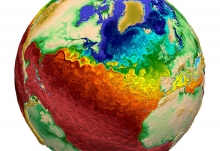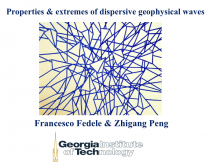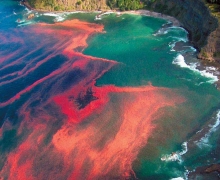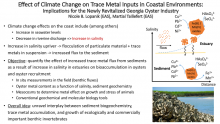- You are here:
- GT Home
- Sciences
- Home
- List of Available Research Projects
The project aims at further testing a new approach, the maximum entropy production (MEP) model of surface heat fluxes (Wang et al, 2014), for modeling and monitoring air-sea exchange of water and heat air-sea water and heat.
The project aims at further testing a new approach, the maximum entropy production (MEP) model of surface heat fluxes (Wang et al, 2014), for modeling and monitoring air-sea exchange of water and heat air-sea water and heat.
Nonlinear dispersive wave groups or packets occur in a wide range of natural systems, exhibiting complex behaviors especially in focal zones where there is rapid wave energy concentration and possible wave breaking. In the presence of dispersion, pure plane waves of different wavelengths and directions traveling within a medium have different propagation velocities. Important classes of geophysical wave systems include surface gravity waves, oceanic and atmospheric internal waves, and seismic waves.
The recently completed resource assessment for ocean current energy (Haas et al. 2013) utilized fairly simplistic analytical methods to estimate the extractable energy from the Gulf Stream System as well as to analyze the relative impacts of large scale energy extraction. This level of analysis can be considered to be accurate to an order of magnitude and only provides an idea on the overall trends of the impacts of extraction. Much higher resolution modeling is required to accurately determine the overall impacts of extraction for both localized and far field effects.
The student will work jointly between the labs of Drs. Frank Stewart (Biological Sciences) and Kostas Konstantinidis (Biological Sciences, Civil and Environmental Engineering) to characterize a globally important marine bacterial group (SAR11). A collaboration between these labs recently described how SAR11, the world’s most abundant organismal group, has adapted to the unique chemical and physical environment of anoxic oxygen minimum zones (OMZs). This work (Tsementzi et al.
The student will work jointly between the labs of Drs. Frank Stewart (Biological Sciences) and Kostas Konstantinidis (Biological Sciences, Civil and Environmental Engineering) to characterize a globally important marine bacterial group (SAR11). A collaboration between these labs recently described how SAR11, the world’s most abundant organismal group, has adapted to the unique chemical and physical environment of anoxic oxygen minimum zones (OMZs). This work (Tsementzi et al.
Single-celled marine algae are especially chemically rich, producing toxins that kill fish, marine mammals, and seabirds, contaminate shellfish, and threaten human health. Many predators of these algae – copepods – selectively consume less toxic algae, which in turn sense copepods via an excreted blend of copepod-specific molecules. These algae then become up to 20X more toxic when they sense copepod cues in the open ocean.
Single-celled marine algae are especially chemically rich, producing toxins that kill fish, marine mammals, and seabirds, contaminate shellfish, and threaten human health. Many predators of these algae – copepods – selectively consume less toxic algae, which in turn sense copepods via an excreted blend of copepod-specific molecules. These algae then become up to 20X more toxic when they sense copepod cues in the open ocean.
Deep subsurface methane hydrate-bearing sediments contain microbial communities that are distinct from shallow marine sediments and hydrate-free environments. DNA evidence suggests that novel bacterial phyla (e.g. Atribacteria) are highly enriched in methane hydrate-bearing sediments. Recent genome assemblies by the Glass group at Georgia Tech are providing insights into the metabolic potential of samples drilled from gas hydrate stability zone 70 mbsf below Hydrate Ridge (IODP Leg 204).
The effects of climate change on the coastal ocean include a decrease in riverine inputs and increase in salinity in estuaries with impacts on primary production, macrofauna, and sediment biogeochemistry that are poorly understood. One clear effect of the increase in salinity associated with the decrease in riverine discharge, however, is the enhanced coagulation of inorganic material further upriver. Flocculation of particulate material upriver will enhance its flux to the sediment and simultaneously decrease the outflux of particulate material to the continental shelf.








